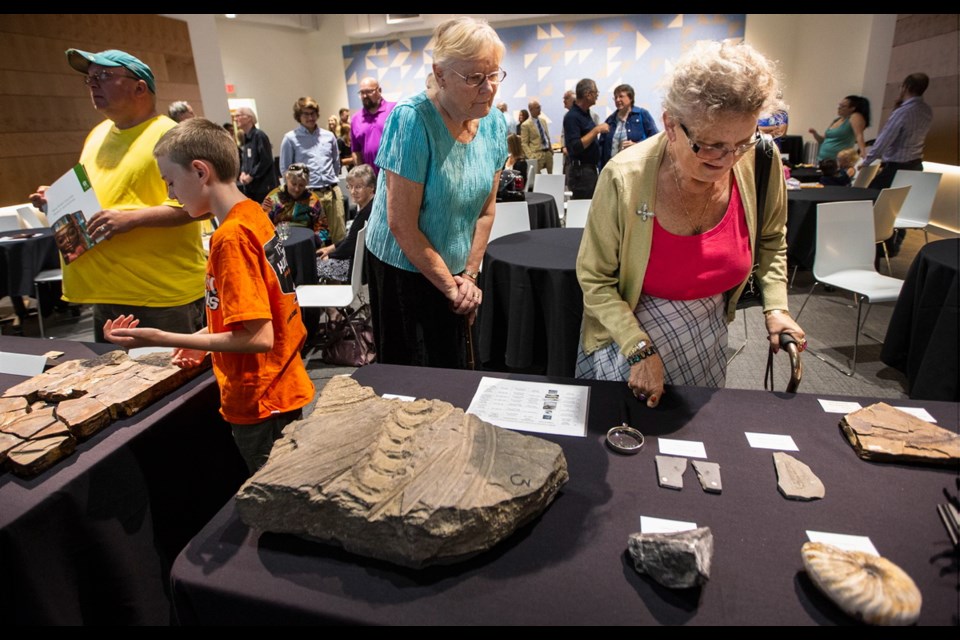The Royal B.C. Museum has received one of its largest-ever donations, a result of the efforts of two men who combed the ground for fossils around Cache Creek.
For years, the late John Leahy and the late David Langevin worked the McAbee fossil beds, which became a provincial heritage site in 2012.
Leahy’s family has donated the men’s collection, estimated to hold about 18,000 specimens.
Neither man had a professional designation in paleontology, but were highly respected and considered “informed amateurs” in the field.
The McAbee fossil area is located in an old lake bed and includes fossilized plants and insects, in particular, from the early Eocene Epoch 52 million years ago. Among items in the Leahy-Langevin collection are a salmon with bones intact, a bird with unusually visible bones and feathers, and a crane fly preserved in delicate detail.
Richard Hebda, the museum’s curator emeritus, believes the collection contains a number of previously unknown species — something that will be studied by museum staff and associates.
“The McAbee site is unique in the world,” Hebda said.
“It has a diversity of species, it has a preservation that’s exceptional.”
And now with so many specimens coming to the museum “people can come and study it in a way that wasn’t possible before.”
The men’s widows were at the Royal B.C. Museum on Thursday to make the donation official.
Linda Langevin said her husband and Leahy were passionate about collecting and organizing the fossils.
“They just loved it,” she said. “And then they saw the potential for everybody to enjoy it, it was a beautiful thing.”
The knowledge they gained was unparalleled, Bernita Wienhold-Leahy said.
“They knew more than anybody about the site.”
Langevin said she would suggest to David that he take courses, but he didn’t see the need and would do things on his own.
“He’d get the books and he’d study and he’d write to people and talk to people.”
With Leahy, the photographic record he developed of the site has been the basis of many scholarly writings by scientists around North America.
Wienhold-Leahy said she is proud to have the collection in the museum.
“I think this is where it belongs.”
Langevin recalled family outings known as “Langevin adventures” to search for rocks and fossils, while Wienhold-Leahy said the two men would often refer to their fossil-seeking sessions as “play.”
“They enjoyed every minute of it,” she said.
Leahy and Langevin were “citizen scientists” and knew what they were doing, Hebda said.
“They had the eye to pick out things that were likely to be scientifically significant.”
Museum deputy CEO Angela Williams said the collection has great significance.
“Today is an important day for the Royal B.C. Museum,” she said.
“And for all British Columbians for that matter, as we accept a truly remarkable donation of fossils into our collection to be shared with researchers, learners and curious members of the public.”
She said that Leahy and Langevin have followed in the footsteps of the other naturalists “whose scientific research and active collecting throughout the province form the backbone of [much] of the Royal B.C. Museum’s natural history collection.”
Fossil Candidates
In concert with the donation, the province has launched a campaign giving people a chance to vote for an official provincial fossil.
The seven candidates, presented alphabetically by scientific name, are:
• Canadoceras yokoyamai, Canadian ammonite
• Elasmosaur or swan lizard
• Eosalmo driftwoodensis, dawn salmon
• Marrella splendens, lace crab
• Olenoides serratus, saw-tooth trilobite
• Shastasaurus sikanniensis, ichthyosaur or fish lizard
• Yabeina columbiana, rice fossil
Vote at surveymonkey.com/r/BC_Provincial_Fossil



